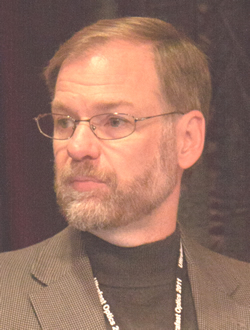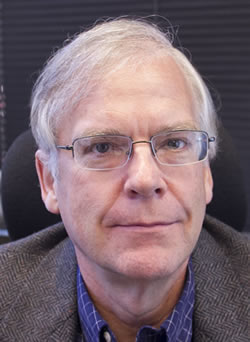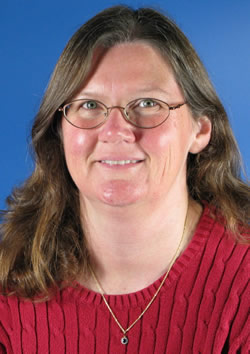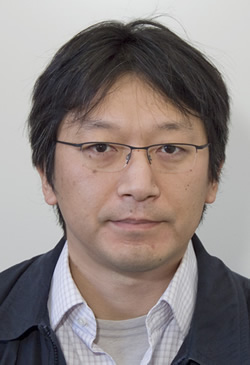NIF & PS People - 2015
January
Five NIF&PS Scientists Named APS Fellows
Five NIF&PS researchers have been selected as 2014 fellows of the American Physical Society (APS). APS fellowships are awarded after extensive review and are considered a distinct honor because the evaluation process, conducted by the fellowship committees of individual divisions, topical groups and forums, relies on nomination and recommendation by professional peers.
Election to APS fellowship is limited to no more than one half of 1 percent of APS’ membership for a given year. The five scientists join five other 2014 APS Fellows from LLNL.
NIF&PS Chief Technology Officer Chris Barty was cited by the APS Division of Laser Science for “pioneering contributions to the advancement of ultrahigh intensity laser science and to the development of laser-based x-ray and gamma-ray science.”
 Chris Barty
Chris Barty Barty’s academic background includes Ph.D. and M.S. degrees in applied physics from Stanford University and B.S. degrees, each with honors, in chemistry, physics and chemical engineering from North Carolina State University. Before his arrival at LLNL in 2000, Barty had been director of laser science for a privately funded research organization at the University of California, San Diego; director of advanced technology for a Silicon Valley laser company; and a member of the Applied Physics and Electrical Engineering faculty at Stanford University.
At LLNL, Barty has served as the chief scientist for the Laser Science and Technology program and was the architect and the first program director of the mission-based Photon Science and Applications program. He has published more than 200 manuscripts and presented more than 200 invited talks spanning topics that include lasers, optics, materials science, medicine, chemistry, engineering and physics. He is currently co-chair of the International Committee on Ultrahigh Intensity Lasers and was previously elected a Fellow of the Optical Society of America and the international optics and photonics society SPIE.
“It is of course a great honor to be recognized by one’s peers, but it is especially gratifying to share this recognition with this year’s class from LLNL,” Barty said. “I am always amazed and inspired at the breadth and the quality of science undertaken here.”
Laser scientist Ray Beach was cited by the Division of Laser Science for “seminal contributions to high-average-power diode-end-pumped lasers, including many breakthroughs, widely adopted by the laser community, that have helped push such lasers to higher average powers and efficiencies, and for leadership in developing diode-pumped alkali-vapor lasers, and models for coherent and incoherent photon echoes.”
 Ray Beach
Ray Beach Since first joining LLNL’s Y Division in 1987, Beach has pioneered many of the current techniques used in the field of high-average-power diode-pumped lasers, and demonstrated a number of firsts in the field. His research and developments in diode lasers and their associated packaging and optical conditioning, and his developments in diode-pumped laser systems, have enabled numerous commercial and Department of Defense applications. His present research in NIF&PS is focused on the development of a new class of laser—the Diode-Pumped Alkali Laser, or DPAL—which was first demonstrated at LLNL in 2002.
Beach received a bachelor’s degree in math and physics from the State University of New York at Buffalo in 1979 and a master’s and Ph.D. in physics from Columbia University in 1983. In addition to being a member of the APS, Beach is an Optical Society of America Fellow, an SPIE Fellow and an LLNL Distinguished Member of the Technical Staff. Beach’s work has earned three R&&D 100 awards.
“Being named an APS Fellow by my friends and colleagues is a great honor,” Beach said. “I feel very privileged to have been chosen, but in the end the accomplishments that have been cited for me are more due to the people I’ve worked with both outside and inside LLNL, and the Lab itself rather than anything I’ve done on my own.”
 Debbie Callahan
Debbie Callahan Plasma physicist Debbie Callahan was cited by the Division of Plasma Physics for “innovative design and modeling of hohlraums for inertial confinement fusion and leadership in the execution of hohlraum experiments on the National Ignition Facility.”
Callahan joined LLNL in 1987 as a graduate student in the Department of Applied Science, UC Davis. She received her Ph.D. degree in 1993 and was hired into X Division as a postdoc working on inertial fusion energy. She has spent her career working on inertial fusion energy (IFE) and inertial confinement fusion (ICF).
Callahan became a group leader for ICF/IFE target design in AX Division in 2007, and associate division leader for ICF Design in 2013. Prior to the start of NIF experiments, she led the Hohlraum Point Design Working Group within the National Ignition Campaign to develop the point-design hohlraum for ignition. She has been involved with NIF experiments since they started in 2009.
In 2012, she was a co-recipient of the Dawson Prize for Excellence in Plasma Physics for work done on NIF. She is currently a co-campaign leader for the High-Foot Campaign on NIF, and has served on the APS Division of Plasma Physics Committee for Women in Plasma Physics and the Division of Plasma Physics Executive Committee.
Physicist Frederic Hartemann was cited by the Division of Physics of Beams for "remarkable insights and significant contributions to the physics of coherent radiation interacting with relativistic electrons."
Hartemann received a Ph.D. in plasma physics from the University of Paris XI in 1986. He worked on free-electron lasers at MIT, first at the Research Laboratory for Electronics from 1983 to 1987, and then at the Plasma Fusion Center from 1988 to 1992. He was at Thomson Electron Tubes & Devices from 1987 until 1992, and was a member of the Thomson Scientific College for distinguished scientists.
He joined UCLA in 1993 and has been working at LLNL since 1994, first as a guest scientist, then as a lab physicist starting in 2001. Hartemann has authored three books, including High-Field Electrodynamics (CRC Press).
 Nobuhiko Izumi
Nobuhiko Izumi Physicist Nobuhiko Izumi was cited by the Topical Group on Instrument and Measurement Science for “outstanding contributions to the development of novel neutron and x-ray diagnostic capabilities for inertial confinement fusion experiments.”
Izumi joined LLNL as a postdoc working in the Inertial Confinement Fusion Program’s Implosion Physics Group. Today, he serves as a physicist with NIF&PS’s High Energy Density Science and Technology Division. He received a bachelor’s degree in electronic engineering from the Osaka Institute of Technology and a master’s in engineering science and a Ph.D. in electromagnetic energy engineering, both from from Osaka University.
“I’m honored to be selected as an APS fellow,” he said. “I have been lucky to have the chance to work with great people here at LLNL. From the very beginning of my days here, I have been impressed by a lot of exciting things. I am really proud of my colleagues—they have given me excellent suggestions, great encouragement and have shown me the value of enthusiasm.”



